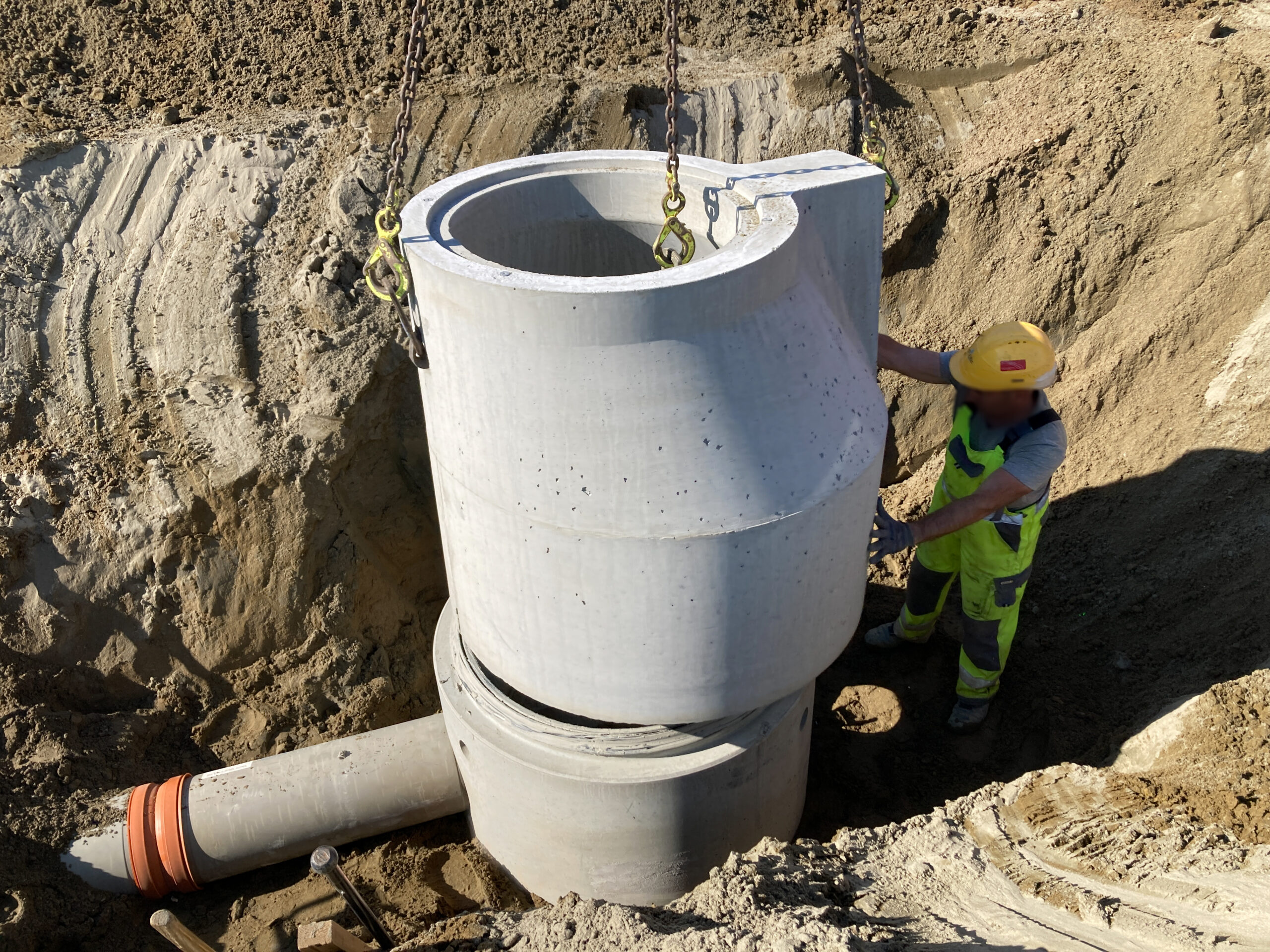

Achieve as much as possible with as little concrete as possible.
For the production of IDEAL inspection manholes and tubes, De Bonte Group avoids the use of unnecessary kilos of concrete, thereby reducing CO2 emissions. Less CO2, but not lower quality. To prevent leakages of seals, the inspection pits are fitted with improved seals with force-diffusion rings. Thanks to modified conical and thus unreinforced surface elements, it is not necessary to mix different raw materials.
Discover the IDEAL range of smart inspection manholes and tubes. All products respect the prevailing standards without impacting prices.
Why choose the IDEAL range?
Quality and robustness
All elements are BENOR-approved and cast in smooth, dimensionally stable self-compacting concrete, guaranteeing quality.
Watertight version
To prevent decompression on seals, the IDEAL channels – the only ones in Belgium – have shear-force prevention as required by European standard. Domestic connections that can withstand the required 40kN load are provided as standard.
Prevention at the construction site – extended service life
’Avoiding errors at placement’ was the starting point when designing these pipes. Therefore, they are equipped with a safe DEHA lifting coupling to ensure optimal installation. When respecting the implementation rules combined with shear-force prevention, optimum service life is ensured. To prevent settlement, the pipes are designed with a flat footing.
Smart design – CO2 reduction
The design of the elements is further optimised to handle the concrete more efficiently. This avoid using excess concrete, without impacting sustainability. De Bonte Group has perfected the IDEAL channels even further so that they meet strength class 160 even without reinforcement. Excavated soil can easily be reused thanks to the flat footing without sand-cement casing.
Easy separation at end of service life
With its well thought through design, De Bonte Group opts consistently for unreinforced tubes and culverts. This makes the complex separation of concrete a past issue. Removing seals is easy and the reinforced concrete can simply be crushed into granulate.
Frequently Asked Questions
• How does shear-force prevention work?
To ensure long-term watertightness, the spigot of our pipe joint was fitted with shear-force prevention. Shear-force prevention is a mechanical device in the joint profile that limits the deformation of the rubber seal. This means that the rubber cannot be compressed more than 50%. At 50% compression of the seal in the lower joint, we always maintain minimum compression of the upper seal to continue guaranteeing the required watertightness. A rubber seal is sensitive to creep. Creep means the tension in the rubber decreases and thus so does the reaction force of the rubber needed to ensure waterproofing. If the deformation is not limited to 50%, the suitability for use as well as the service life will be greatly reduced. NBN EN 1916 also describes shear-force prevention and provides a calculation method.
• What is the point of fitting a pipe with a flat footing?
Any type of pipe in concrete, vitrified clay or plastic is susceptible to differential settlement. Such settlement is caused by poor underfilling of the pipe when laying. The larger the diameter, the more difficult it is to underfill correctly, but also the larger the diameter, the greater the shear-force transmission. So, it makes sense that larger diameters are more sensitive to durable waterproofing. Insufficient excavation of the foundation at the site of the external socket also poses a serious risk of settlement. The integration of a straight flat footing along the full length of the tube avoids this problem. After preparing the flat bed, the flat-foot tube can be placed immediately. Instead of transmitting the shear forces through a very narrow strip under the round tube, the shear forces will be neatly distributed over the entire surface of the flat base.
• How do you create a domestic connection on an IDEAL pipe?
During production, our IDEAL pipe can be provided with a profiled opening with sliding seal to which an elbow can be directly connected.
If it is not possible to connect to 12u00, there is always the option of also providing a borehole in situ in combination with an integrated insert sleeve.
• What is the importance of load distribution between concrete elements?
ue to flatness tolerances at socket and spigot ends, and due to direct contact between the different concrete elements, load peaks may occur at the joint connection, which may cause these elements to break. Even applying a mortar joint between vertical elements does not always result in a static balance. The consistency, composition, curing time of the mortar and the thickness of this joint often vary widely. The load-distribution ring solves exactly this problem. The non-sprung load distribution ring (sand-filled rubber sleeve) absorbs the flatness defects of the superimposed vertical elements and distributes the static and dynamic loads of heavy road traffic. The connection between the vertical elements is established according to DIN V 4034-1 in a simple, economical, reliable and durable way. To ensure greater confidence about the placement of this load-distribution ring, it was integrally connected to the slide seal.
Even with channels or pipes, load peaks can occur due to small irregularities, production tolerances or contamination in the joint connection. To avoid damage, direct contact between 2 concrete elements should also be avoided here. This can be done by placing a rubber strip between socket and spigot, which absorbs these point forces and transfers to the foundation the static and dynamic loads from heavy road traffic and the like.
• How does strength series 160 differ from traditional R135
Our classic cement concrete pipes are produced in strength class 160. This means they are at least as strong as vitrified clay pipes and stronger than the reinforced or steel fibre reinforced concrete R135 variant. Pipes are periodically tested for failure. The statistical interpretation of the fracture strengths ultimately determines the strength series. Minimum fracture load, when testing reinforced or unreinforced pipes, should be understood as ‘brittle fracture’ or ‘implosion’ and not crack load, which is 33% lower. Currently, there is an erroneous perception that shallow placement of sewers requires the use of reinforced pipes. Reinforcement actually forms a discontinuity in the cross-section of a pipe, weakening the concrete in the tensile zone. Therefore, when the first crack forms, unreinforced pipes with the same geometry are stronger than reinforced variants. Reinforcement is only interesting to apply if the resistance to cracking/fracture of an unreinforced pipe is not high enough. Thus, the function of reinforcement is to postpone further cracking or fracture. This also means that the primary function of sewers, being watertight transport of (waste)water, can no longer be fulfilled after initial cracking and that their fitness for use or service life is at an end. For the sake of waterproofing requirements, using reinforcement in pipes is actually a ridiculous stopgap measure! It is sheer waste of resources! Specifically, a reinforced pipe with strength class R135 actually only has a ‘crack strength class’ of 90 and our unreinforced pipes are almost twice as strong. They are also a better value and much easier to recycle. Corrosion due to chloride degradation has also been eliminated.
• How is a slide seal applied?
Place the slide seal evenly on the shoulder of the spline and distribute the tension by lifting and releasing the slide seal at a few points.
• Which connections are possible to our IDEAL access pits?
- All PP, PVC and HDPE pipes whether smooth or not
- Vitrified clay, both high load and low load
- Concrete pipes from any Belgian manufacturer with embedded seals
- THIOTUBE
- Cast-iron tubes
Want to know more?
Contact one of our experts



